Splatoon 2 Review
Nintendo’s freshest franchise splashes down on Switch
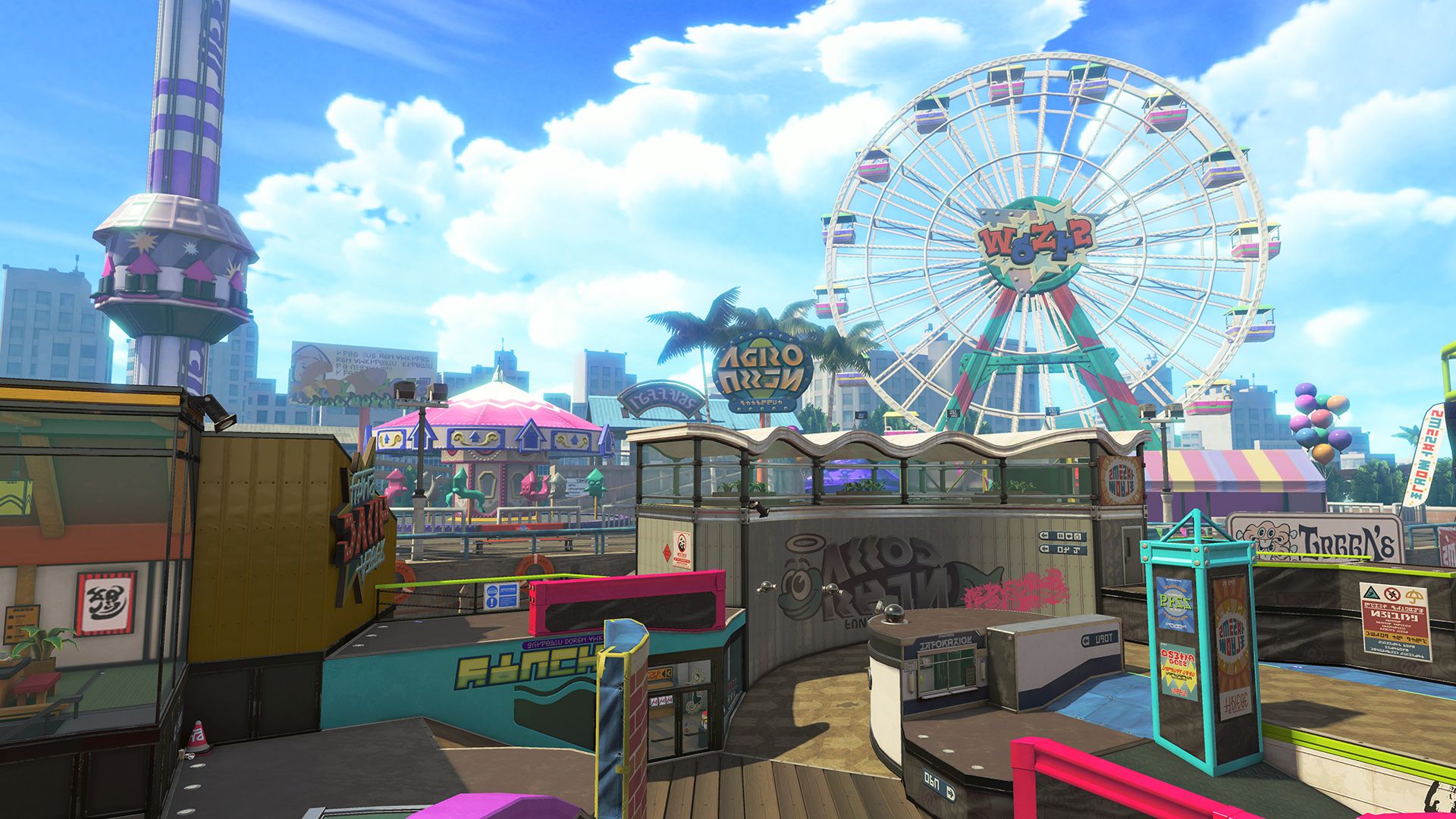
This game was reviewed using an eShop code provided by Nintendo for Nintendo Switch.
Over the last couple of weeks, I have been trying to describe Splatoon 2. My sister owns a Wii U — and is a big Wii U enthusiast — but she never played the original Splatoon. The topic came up because we were comparing notes on the genuinely great Wii U exclusives that we’d missed for one reason or another. For me, it was Donkey Kong Tropical Freeze, and for her it was Splatoon.
I didn’t do a very good job explaining what Splatoon is.
“It’s a first-person shooter, isn’t it?” she asked.
“Er, yeah, kind of…” was my tentative reply. “It’s sort of like a first-person shooter crossed with a platformer. Think about Super Mario Sunshine, but instead of spraying water, you’re spraying paint, and you can transform into a squid to swim through the paint, and…”
Yeah.
Needless to say, my final comment was: “You really just have to play it to understand it. Come over, and I’ll show you.”
So, she came over and played Splatoon 2. Then, a couple of days later I received this message from her: “I bought Splatoon 2!”
At that point, I’m sure a smug grin crept across my face. I knew she’d buy it. Once she got to play it for herself, there was no question!
The life aquatic
Let’s start with the basics. When you begin the game, you’re asked to create a character and you then move through a brief obstacle course on your way to Inkopolis Square, the game’s main hub area. The tutorial itself is fun, and teaches you the basic mechanics, which are admittedly pretty different to any other video game at least in one important sense.
Yes, you’re essentially playing a 3D platformer — that’s how it feels at first. But you’re also wielding a gun that shoots paint from a little canister on your back. Shoot enough paint, and you’ll quickly run dry. This is really where the magic happens; if you squeeze ZL, you’ll morph into a squid and dive right into the ink you’ve just sprayed. Holding ZL enables you to remain submerged, and while you’re submerged your ink canister refills.
Once you understand this basic mechanic, your mind suddenly opens to the extraordinary potential these simple abilities grant you.
For example, you can spray ink up a wall, dive into the ink as a squid and swim up the wall to a high platform. You can splash ink across several platforms, and then hop from one to the next as a squid, gracefully diving in and out of the shimmering neon ink. Not only does it look great, it feels awesome — as you might expect from Nintendo, the controls are sublime. And they need to be, too, especially when you jump into fierce and frenzied online multiplayer battles.
Once you reach Inkopolis Square, you can dig into the game proper. This includes everything from jumping into one of the main gameplay modes to chatting with the various vendors who populate the square, and who sell everything from items of clothing to weapons, and even food.
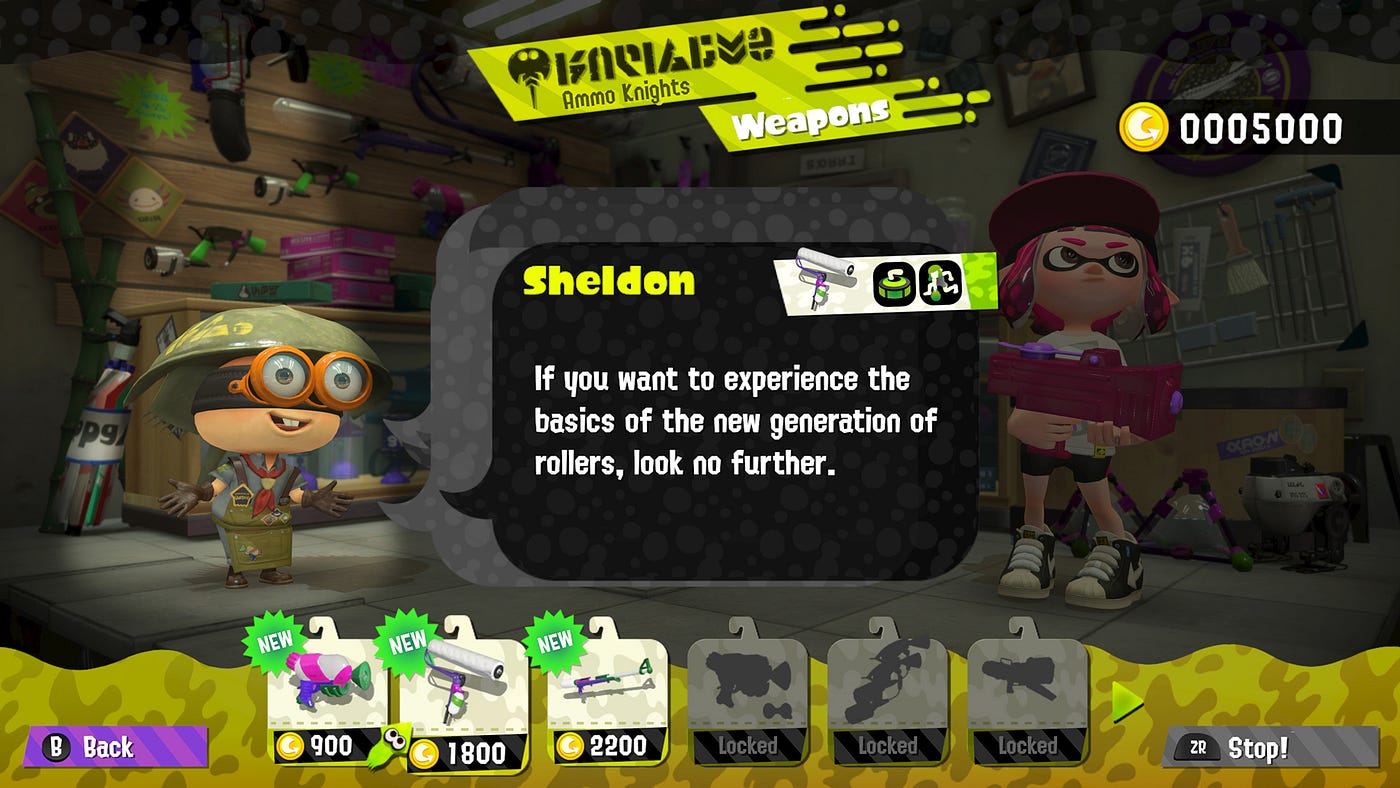
The characters in Splatoon 2 are fantastic. Each one riffs on the squid/sea creature theme in some way (perhaps with the exception of Judd and Li’l Judd). And then there’s Pearl and Marina, the new pop-star duo from the in-game band Off the Hook who pretty much act as the game’s official MCs (and who have become weirdly controversial in fan culture — just Google “Pearl and Marina” and you’ll soon see what I mean).
Inking your turf
You’ll likely spend most of your time in Splatoon 2 playing one of the game’s online multiplayer modes. The primary mode is Turf War, where teams of four are awarded points based on the amount of turf they cover in their team’s ink. Each round lasts for three minutes, and once the round ends, Judd and Li’l Judd appear on-screen to determine the winning team.
Teams are pulled together through Splatoon 2’s matchmaking system, which works relatively well provided you are not intending to team up with a specific friend (more on that later). Also — and this was a bugbear of mine from the original game that still hasn’t been fixed — you can’t change your load out between matches. So, if you’re experimenting with a particular weapon and you want to change, you’ve got to exit out of the matchmaking lobby to change your gear. It feels needlessly clunky and time-consuming.
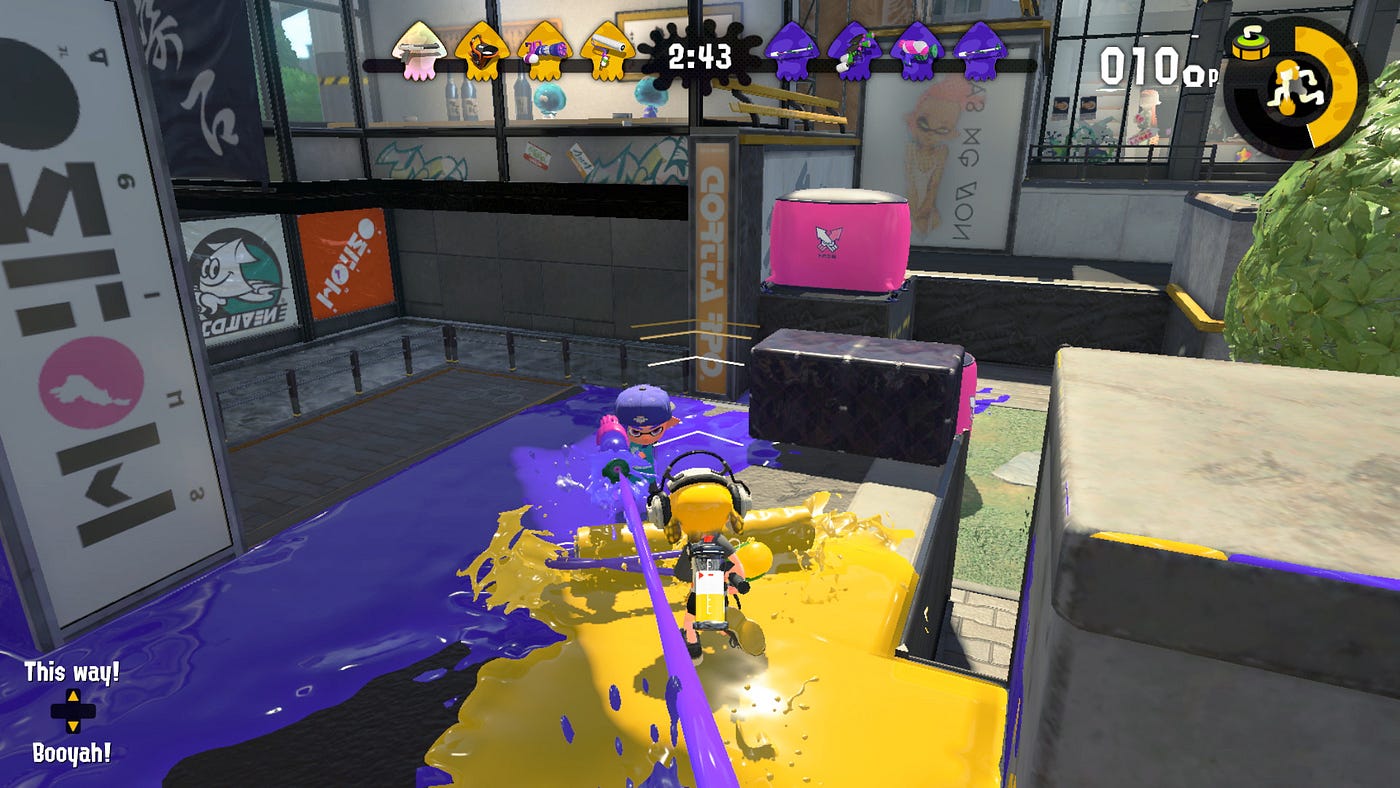
In addition to the regular Turf War mode, you can also play Ranked Battles and League Battles. These latter modes open up as you progress through the game (to enter Ranked Battles, you’ve got to reach Level 10 via Turf War and to enter League Battles, you’ve got to achieve a rank of at least B- in any Ranked Battle type).
Whichever mode you’re playing, you’re always building towards something, either in terms of earning money or experience. As you earn experience, your character will level up, and this will in turn grant you access to higher-level gear.
There are several game types within Ranked Battles and League Battles. Splat Zones is somewhat like Turf War, but instead of inking the entire map, your team’s goal is to ink a specific highlighted area and keep it under your control for as long as possible. Tower Control involves riding a moving tower across the map, with the aim of riding it into the enemy team’s base. And finally, Rainmaker is a capture the flag style game where your goal is to pick up a special weapon (the aforementioned Rainmaker) and carry it into the enemy’s base.

What’s interesting about all of these online modes is the unique way that Splatoon 2 keeps things varied. In each of the above modes, there are always two maps in play at any given time (you can’t choose the map, it’s selected randomly by the game). The two active maps rotate through every two hours. In addition, the current Ranked Battle or League Battle mode also rotates at the same time. This means that when you enter, say, Ranked Battle, the active mode might be Tower Control. But in a couple of hours, it will change to Splat Zones.
A similar rotation system existed in the first game, and it’s not without its detractors. Some players would definitely prefer that all maps and modes are in active rotation at all times. I actually felt this way when I first played the original game on Wii U, but over time my view has changed; I don’t mind the rotation system now, because I think it strikes a good balance between allowing me to build familiarity with maps (which ends up being quite advantageous), while still keeping things fresh.
Whichever mode you’re playing, you’re always building towards something, either in terms of earning money or experience. As you earn experience, your character will level up, and this will in turn grant you access to higher-level gear. And as you earn money, you’ll actually be able to purchase that gear and expand your repertoire.
Squid style
I want to pause for a moment to talk specifically about gear, because it’s such a fundamental part of the game. You can buy headwear, footwear, and shirts right from the beginning, but you’ll gain access to higher-level gear as you level up. You’re also able to examine other players who are wandering around Inkopolis Square to take a closer look at their gear. If you like what you see, you can order those items and they’ll be available to purchase via a new character called Murch.
You can also access the new Nintendo Switch Online app to order exclusive gear that changes regularly. When you place an order on the app, you’ll be told how long it will take to deliver the gear in-game (for example, it might take a couple of hours), where you’ll then be able to pick it up from Murch. This method typically allows you to access gear that has up to four item slots.
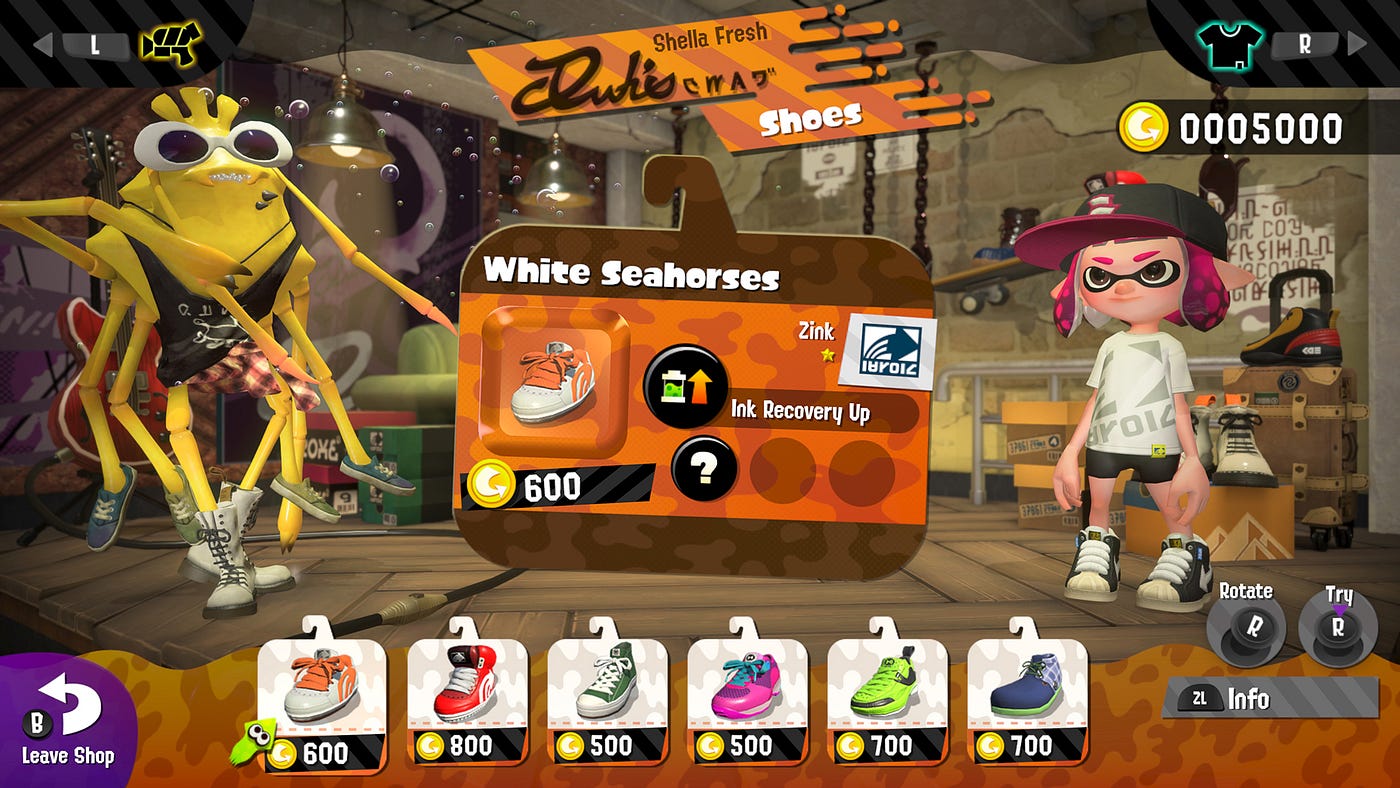
Speaking of which, each piece of gear will have at least one item slot (depending on the level of the gear — higher-level stuff will carry additional item slots). As you gain experience in online multiplayer modes, each piece of gear you’re wearing will also “level up”, with empty item slots being filled as you gain each new level.
You don’t need to be great with aiming (or great with FPS games in general) to enjoy Splatoon 2, especially in Turf War, where the object is to ink as much turf as possible.
This is really where gear becomes so strategically important. Each item slot on each piece of gear can carry a particular buff (known as an “ability”), which can be vital when playing online, especially in the Ranked and League Battles. The abilities vary greatly; some will refill your ink much faster, others will allow you to walk more quickly on enemy ink, and others still will power up your sub-weapon more rapidly. These abilities are randomly generated as your gear levels up, but you can apparently re-roll your gear if you want different abilities (I haven’t tried this yet, so I can’t comment on it).

Of course, the most vital piece of gear you can possibly acquire is your weapon, and Splatoon 2 really delivers in this area. There are fairly standard gun-like weapons (such as the default Splattershot Jr.), and then there are the more bizarre items like the Splat Roller (my personal favourite) or the Slosher, which is literally a big bucket full of paint that you can throw around.
In addition to numerous returning weapons, Splatoon 2 offers a host of new ones, such as the awesome Splat Dualies (little dual-wielded paint pistols that allow you to quickly dodge-roll to avoid enemy fire). So far, Nintendo have added the Splat Dualies and Dapple Dualies to the game, but more weapons are coming in future updates (including really crazy stuff like the Splat Brella).
As well as wielding a main weapon, you can also access a sub-weapon and a special weapon that charges up as you ink turf. The variety is fantastic and the special weapons in particular are incredibly fun — one of them allows you to activate a literal paint storm (ominous paint clouds materialise in the sky, raining down your team’s paint colour all over the enemy).
This weapon variety feeds into the notion that Splatoon 2 is not simply a first-person shooter. Yes, you can kind of play it that way, but the depth and breadth of tactics available to you are much wider than that. You don’t need to be great with aiming (or great with FPS games in general) to enjoy Splatoon 2, especially in Turf War, where the object is to ink as much turf as possible — you can equip the Splat Roller, for example, and focus on inking as much ground as possible around your team’s base rather than going toe-to-toe on the front lines, if you so choose.
The fact that you can clearly contribute to your team’s overall success without being a great marksman is an important defining feature of Splatoon 2’s online multiplayer.
Angry salmon
Perhaps the biggest change in Splatoon 2 is the arrival of a brand new mode called Salmon Run. It has been described as a horde mode, and that’s kind of what it is, but there’s great deal of nuance here.
Unlike the main online multiplayer modes, there’s no player-versus-player aspect to Salmon Run; it’s purely a cooperative experience. You team up with three other people (via matchmaking), and don your overalls to do a shift for the questionable in-game company, Grizzco Industries. Grizzco, it turns out, is after Golden Eggs, but collecting these treasures isn’t easy — you’re required to travel to deep into Salmonid territory to harvest them. Needless to say, the Salmonids are none too happy about this, and will deploy everything in their arsenal to stop you.

As you start each round of Salmon Run (there are always three rounds in total), you’ll be allocated a weapon automatically. The inability to manually choose a weapon is important here; the game will force you to become at least somewhat comfortable with each major weapon type. I personally found this difficult at times, because I tend to gravitate towards one or two main weapons in Turf War and the other modes, so Salmon Run regularly yanked me from my comfort zone.
In each round, you’re given a simple quota of Golden Eggs to harvest. As the round progresses, you’ll be attacked by waves of Salmonids of different sizes and capabilities. In amongst these, the game will alert you to incoming bosses — defeating the bosses is key to nabbing enough Golden Eggs to fulfil your quota.
There are seven unique bosses in Salmon Run, and each one requires a different strategy to defeat.

The Stinger, for example (pictured above) will sit atop a tower of pots at the edge of the water and will fire a powerful paint beam long distance (including through objects). The key to taking out this guy is to knock out the pots from underneath him — once they’re all gone, he’s done for, and he’ll leave behind three precious Golden Eggs.
Grizzco, it turns out, is after Golden Eggs, but collecting these treasures isn’t easy — you’re required to travel to deep into Salmonid territory to harvest them.
As the rounds progress — and as you play Salmon Run on tougher and tougher difficulty settings — the action becomes more and more intense. Pretty soon, your crew will be swarmed with multiple bosses at once. On these occasions, close coordination with teammates is key, which leads me to my next point (and easily the most disappointing aspect of the game).
I should also mention that you can play Salmon Run via local wireless play. I didn’t test this mode out because I wasn’t able to get another person in the same room with the game and a Switch, so I won’t comment on that aspect.
One final point — and a curious one — is that Salmon Run is not always available. Grizzco is only open occasionally, for a couple of hours at a time. I have read (via a third-party) that this is because Nintendo doesn’t want to detract too much from the primary online multiplayer modes. I’m not sure if I buy that. Either way, it can be frustrating not to be able to access Salmon Run whenever I want (especially because the bonuses you earn in Salmon Run feed directly into your progress in the more competitive modes).
Something’s fishy
By now you’ll likely be aware of the weird voice chat system that Nintendo has designed for Splatoon 2. Although the system is debuting with this game, it’s worth noting that the same solution appears to be in mind for any and all Nintendo Switch titles that will have voice chat capability.
Before I talk about the actual setup, it’s worth saying that voice chat is inherently limited in Splatoon 2 anyway. For example, you can’t access voice chat in any of the modes I’ve described in this review so far. If you’re playing any of the competitive modes (like Turf War), you’ll need to set up your own lounge and invite specific players to join voice chat (this can either be friends, or people you’ve played with in Splatoon 2 during your current session). In this way, voice chat is completely gated off from the other regular modes (it’s not entirely a bad thing, but I’d have preferred the ability to just activate/deactivate voice chat throughout the game).
The mechanics of setting up voice chat are not laborious per se, but they still feel unnecessarily fiddly.
To begin with, you’ll need to download the Nintendo Switch Online app for your smart device. You can connect it to your Nintendo account, and it’ll automatically recognise that you’re playing Splatoon 2.
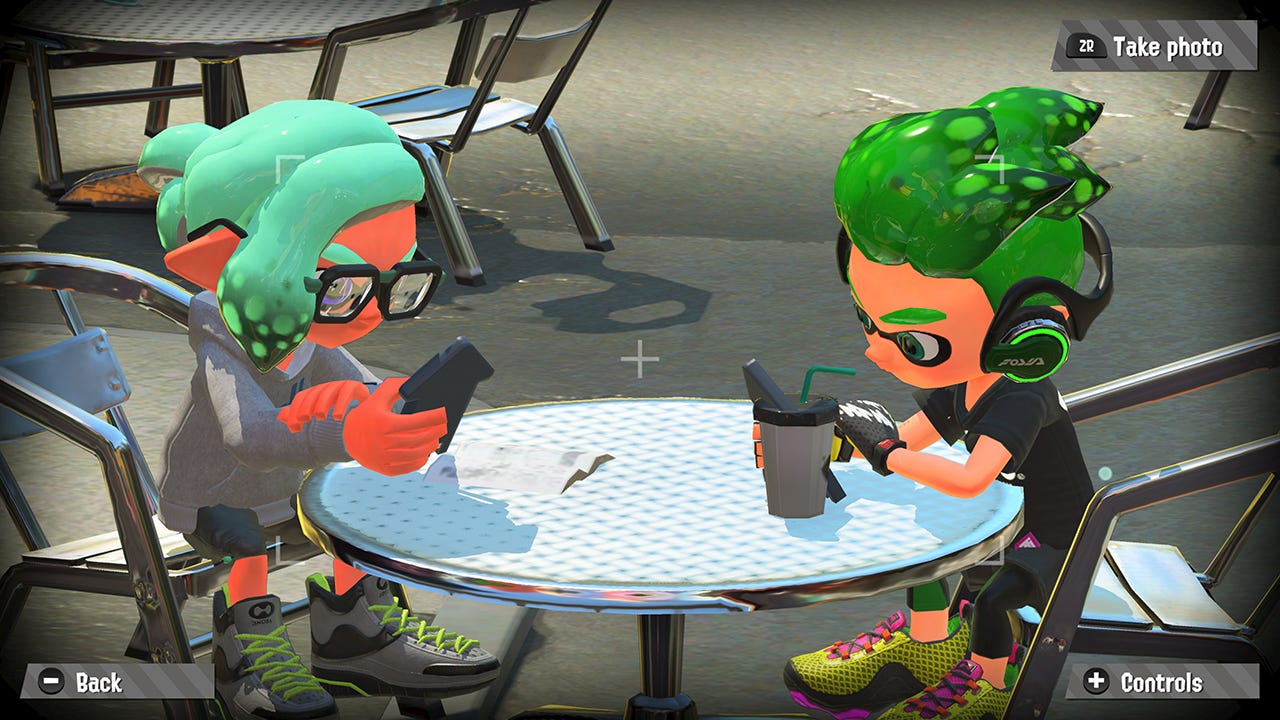
When you’re inside the app, there are actually a number of interesting and useful things you can do related to Splatoon 2, including checking out your win/loss record, reviewing the stage and mode rotation timetables, and ordering exclusive gear that will get delivered to you in-game. You can even see how much turf you’ve painted overall, and compare it to major landmarks in the real world. All that stuff is pretty cool.
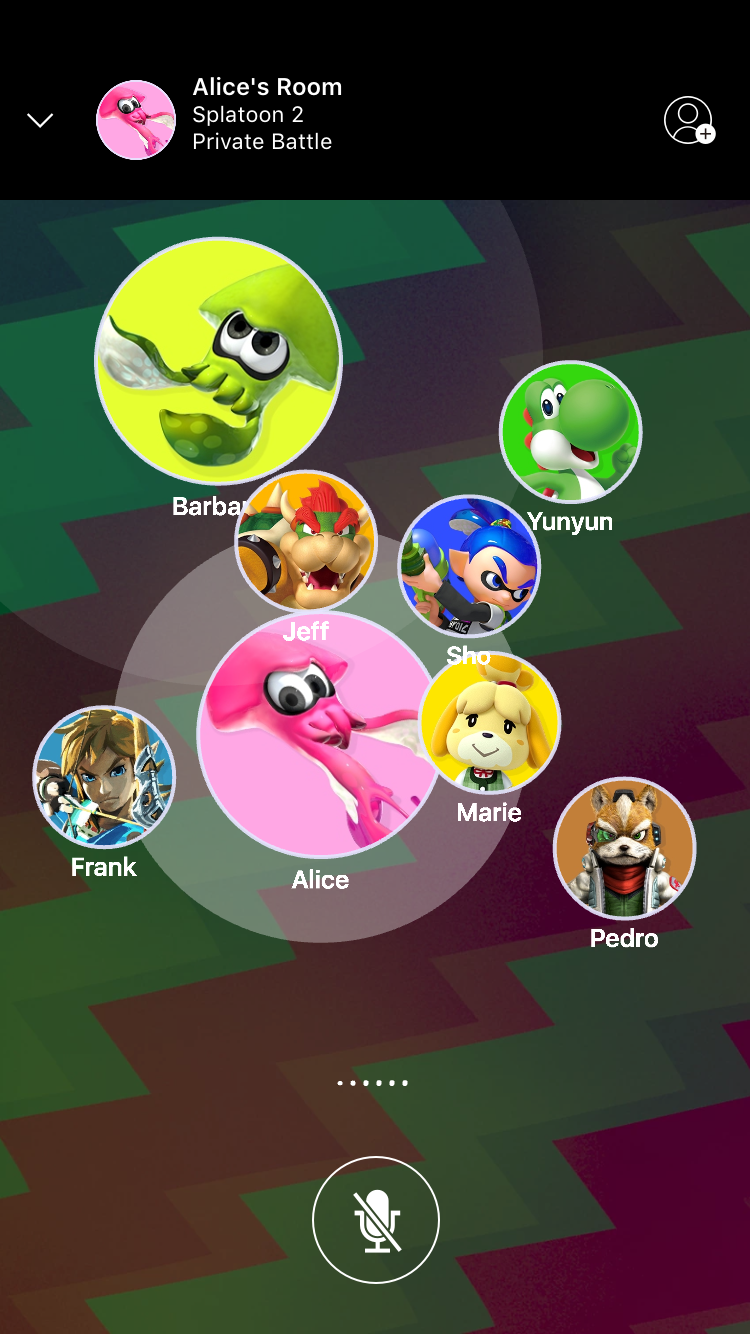
As mentioned above, you’ll have to create your own lobby and invite people if you want to voice chat. When you do this, Nintendo Switch Online will create a voice chat lobby within the app itself. At this point in time, you need to keep your phone unlocked with the app open to actually keep voice chat running, which feels utterly absurd. I’m hoping that will be addressed with a future update to the app.
If you’re playing the game in TV mode, then you’ll be in the weird position of having game audio coming out of your TV or speaker setup, but having voice chat coming out of the earphones you have connected to your smart device. It feels cumbersome and unwieldy, especially compared to the far more elegant options available on PlayStation 4 and Xbox One.
Luckily — and this is a concession I shouldn’t have to make — voice chat isn’t critical for Splatoon 2, unless you’re playing Salmon Run at a really high difficulty. For the most part, you can get by very well without ever directly communicating with your team in the game. If you really need to do it though, you can use the D-Pad to call out to your team using common phrases like “This way!” or “Help me!”.
The mechanics of setting up voice chat are not laborious per se, but they still feel unnecessarily fiddly.
That said, the cumbersome nature of voice chat makes it almost redundant for Splatoon 2. It’s very fortunate that the game doesn’t really require it. But I can imagine that future online games with a strong emphasis on communication will be significantly hampered by this solution, so, I hope Nintendo takes the feedback on board and sorts it out before too long.
Hero of the deep
There’s one more arrow to add to Splatoon 2’s quiver, and it’s a rather large one: Hero Mode. This is the single-player component of the game, and it’s a surprisingly broad and robust mode in and of itself. The entire mode takes place in a mysterious location called Octo Valley, which is well outside Inkopolis Square, and can be accessed through a suspicious grate near the entrance to Grizzco Industries.
If you’ve never played a Splatoon game, you may be surprised to find that there actually is something of a plot going on here. I won’t spoil it for you — and it’s certainly not anything to write home about — but it’s a fun little aspect of the game, which is aided in no small part by Nintendo’s brilliant (and brilliantly funny) localisation. More than anything, it’s the characters and dialogue that grant Hero Mode its own personality and context.
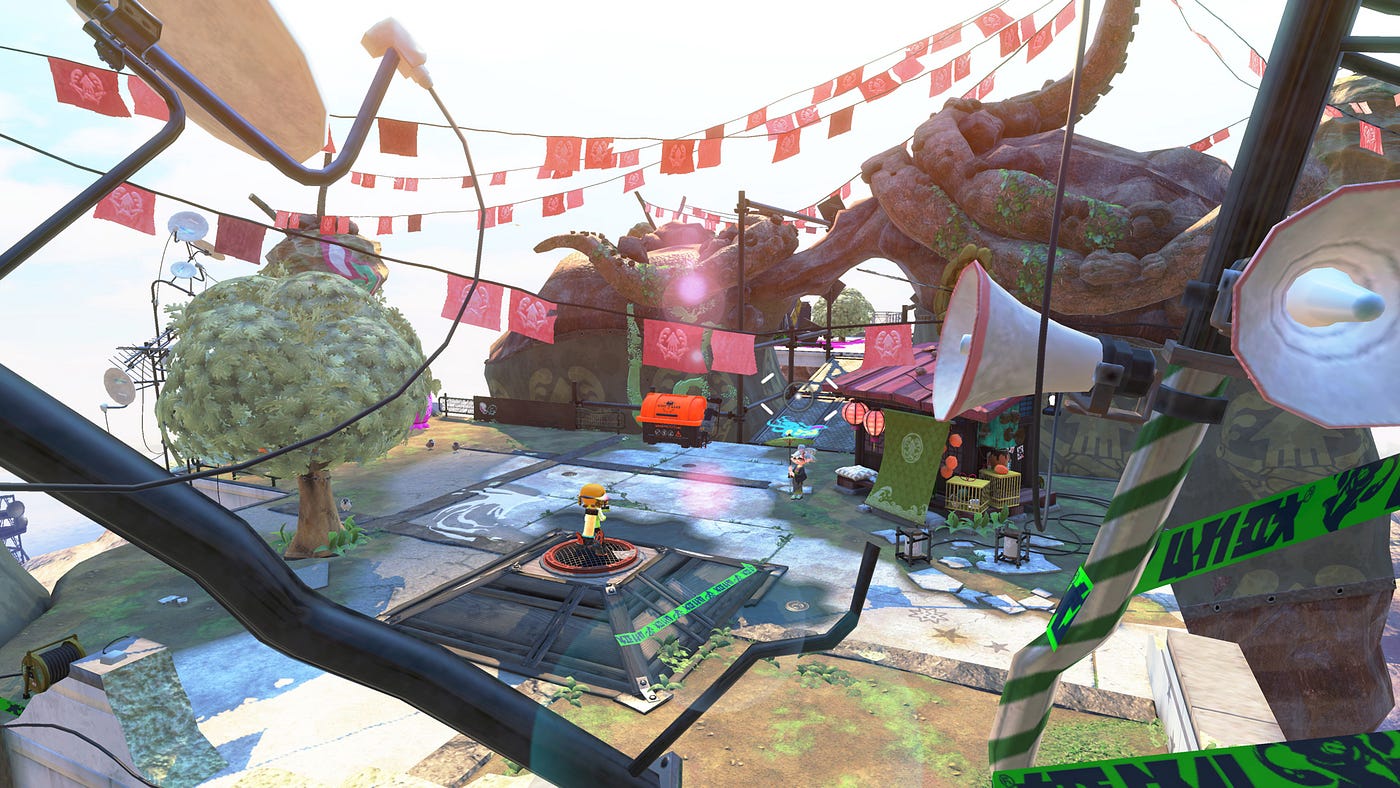
Octo Valley is essentially divided into five major “worlds”, each with a different theme. As you enter each world, you have to locate little teapot-shaped grates that act as entrance points for the individual levels.
As you move through the world, you’ll regularly be asked to “test” various weapons by Sheldon, the weapons dealer from Inkopolis. The level in which you test the weapon is always specifically designed to take advantage of that particular weapon’s unique capabilities. In this way, Hero Mode enables you to gain familiarity with each class of weapons, which in turn encourages you to experiment with different load outs in the various online modes.
You can also change weapons and play the levels with any weapon you like, which is a nice change of pace from the first game, which didn’t offer any weapon variety in single-player at all.
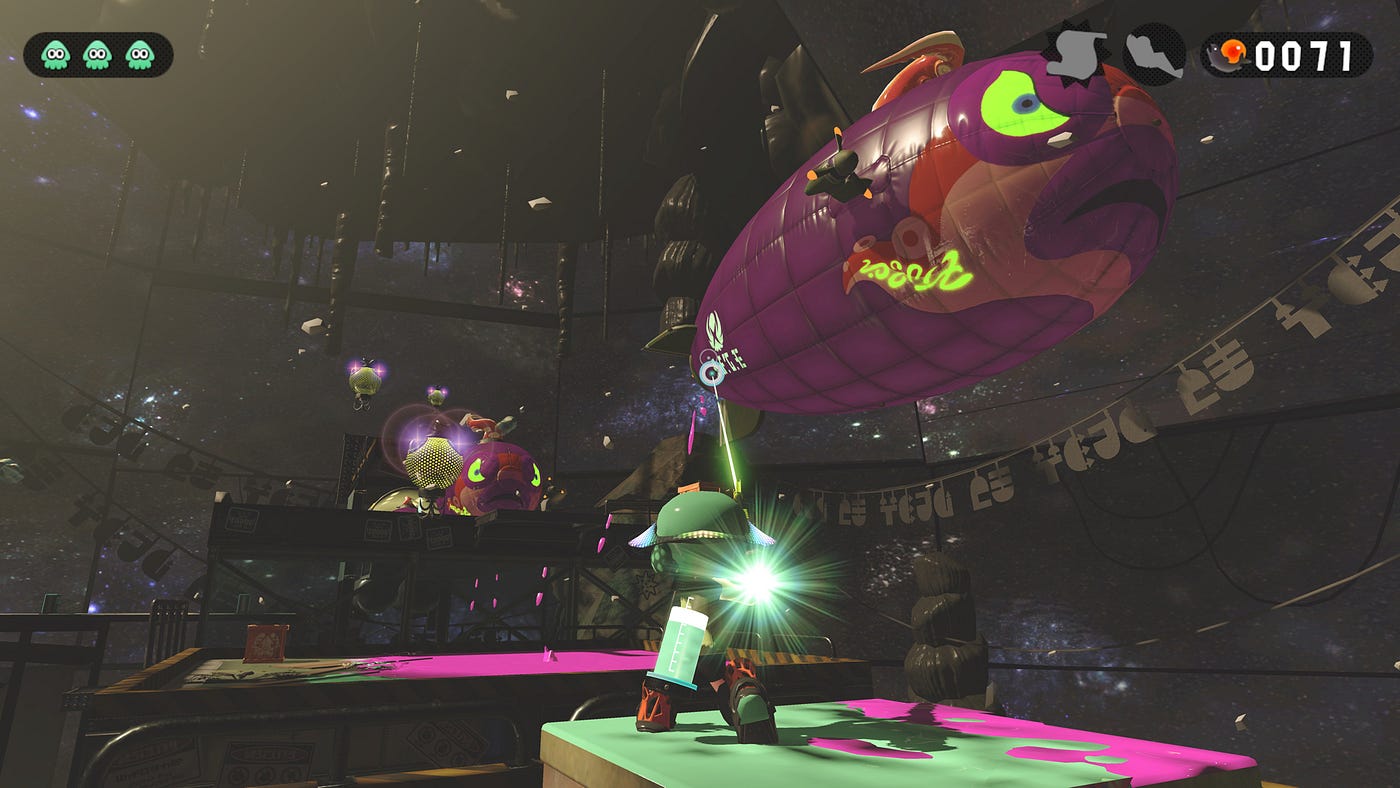
The level design in Hero Mode is wonderful. As I was playing through it, I often felt that the development team were pouring in everything that Nintendo had learned from games like Super Mario Sunshine and Super Mario Galaxy — there are many moments where you’ll feel the DNA of those games expressed with a vivid neon flourish that feels distinctly Splatoon.
The enemies (Octarians) are brilliantly designed, and they regularly force you to quickly change strategy. For example, the most basic Octarians can be killed by simply shooting paint at them, but some Octarians wear big plastic masks to protect themselves; you’ve got to find a way to distract them and then fire from the side or rear to knock them out. You’ll also regularly come across bigger, tougher baddies that feel like they require every tool at your disposal to overcome.

The ability to spray ink and swim through it lends an incredible fluidity to the platforming, as well as offering some truly mind-bending ways of navigating through levels (especially if you want to pick up the various hidden items that are littered throughout each area).
I often felt that the development team were pouring in everything that Nintendo had learned from games like Super Mario Sunshine and Super Mario Galaxy.
And although this game looks gorgeous in every mode, I really noticed the visual design in Hero Mode. The levels looks stunning; some of the later environments are utterly mindblowing in my opinion (including one area that is set at night; your shimmering neon ink is beautifully illuminated by the lighting throughout the level).
The icing on the cake takes the form of bizarre and hilarious boss battles, which have to be seen to be believed. To give you just one early example; the first boss consists of a giant oven which ejects massive loaves of bread that you can paint to navigate your way to the top, where you have to attack a large tentacle protruding up in the air. It’s crazy stuff, and it definitely gets even weirder as you progress further. But each boss is satisfying, and is a wonderful example of Nintendo’s ability to create ingenious enemy encounters.
Final thoughts
It’s easy to recommend Splatoon 2 to any Switch owner. If you never owned the original game on Wii U, then I can recommend Splatoon 2 without reservation; it’s one of the most innovative, colourful, and creatively designed games Nintendo has ever made (and that’s saying a lot, considering its contemporaries on Switch).
Don’t worry if you aren’t keen on (or good at) FPS games, either; you don’t need to be, and Splatoon 2 is much closer to a platformer than a pure first-person shooter anyway.
If you owned the original Wii U game, then whether or not you go for Splatoon 2 will really depend on how much you enjoyed the first. If you loved it as much as I did, then Splatoon 2 is an absolute no-brainer; there’s more of the same great gameplay with enough genuinely new additions to make this a worthwhile investment.
The only big negative here is the poor design for voice chat. Again, I don’t believe this is a deal-breaker because voice chat isn’t really required in this case — however, if you intend to use voice chat heavily while playing Splatoon 2, you should definitely go in with your eyes open.
